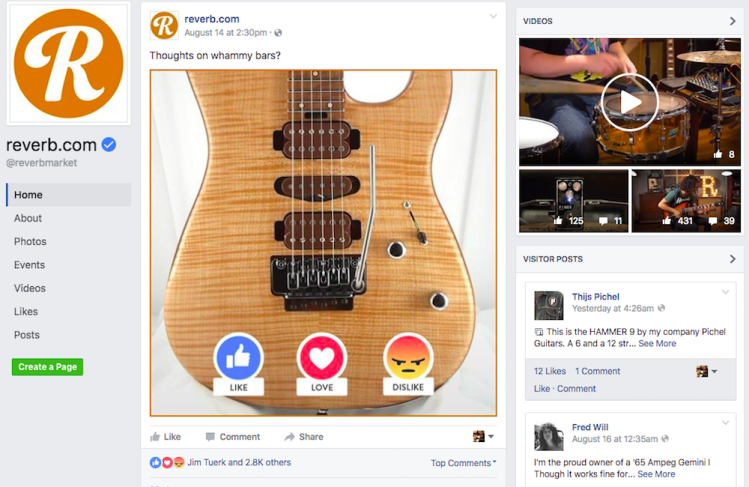Building social audiences won’t get you anywhere without using the data they generate to learn and convert. Join our free social analytics roundtable to find out how Reverb built their business on not just rock ‘n’ roll, but using the power of savvy social strategy and masterful analytic insights.
In just three years, Reverb.com has gone from three employees to over 100, welcomes seven million visitors every month, and has the become the fastest growing community of musicians and most popular music gear website in the world.
Much of their success is based on their thriving social media communities on Facebook — where posts often become a forum for users to chat — Twitter, and Instagram. And wouldn’t it be great if you could just get a blueprint of exactly how they’ve built and leveraged their audience? But that’s one of the biggest mistakes marketers can make in the industry, says Chrissy Hansen, Reverb’s director of marketing.
“People look to general social media best practices,” Hansen says, “But every business model is different. Every audience is different. It depends on what your business is — or what your audience is looking for. Best practices for you may be very different than what they are for someone else.”
She admits that Reverb has a bit of a leg up when it comes to engaging audiences. “In one of my previous jobs, I was selling pest control products,” she laughs. “That’s completely different. Reverb has something that’s already a sexy product — it’s a guitar, it’s an effects pedal, it’s a synthesizer. These are really cool things that people are looking for and researching as part of their free time, their entertainment.”
The company is able to leverage the power and pull of the industry on musicians — and aspiring musicians, as well as fans of the famous performers who sell their instruments on the site — to capture fan attention.
“We make demo videos and write articles that are super engaging, interesting and entertaining, and we can get rock stars to come in and do these videos,” Hansen explains. “So that’s something that’s unique to us, and would make it really hard to translate that type of success for a different industry.”
At her previous, somewhat less sexy company, Hansen says, the strategy was slightly different.
“We would write a lot of very educational articles and white papers,” she says. “And then we would look for opportunities in the news, when something would happen that we could lend our expertise to whatever had just happened.”
But, she says, whatever overarching strategy you find works best for engaging your audience, when it comes to calls to action there are commonalities.
“Something as simple as just telling your audience what you want them to do — they will just do it,” Hansen says. “It’s so simple, and I wouldn’t have thought it would be so straightforward. But if you put up a post and you put the words ‘Share this if you agree,’ people will share it.”
However, it’s essential to tailor even that strategy to not only your audience but to the platform you’re on. “That’s one thing we’re always keeping in mind,” says Hansen. “The way that people use each one of these platforms is extremely different. And for each one of those, we have different goals.”
Facebook offers highly segmented audience targeting that allows the company to be very conversion focused, and offers the detailed analytics that inform their strategy to drive transactions.
On Instagram, the main goal is to share spectacular images and garner likes and comments, with some focus on transactions when links are added to products. Twitter, Hansen says, is the least focused on driving transactions for them and more focused on getting as many retweets and engagements and comments as possible.
“And that requires being more clever, being entertaining, putting something out there that people will connect with and feel compelled to share,” she says.
Whatever platforms you focus on and tactics you device, Hansen says, “always be testing” remains as true as ever, no matter what industry you’re in.
“Just try as many different things as you can, because you will come across surprises,” she says. “There will be interactions that happen that you didn’t expect; and the only way to find that out is if you try a lot of different things. Just try them all, and you’ll find which things work best for your audience.”
In this free VB Live event, join VB’s own Stewart Rogers, Chrissy Hansen, Director of Marketing, from Reverb and Ethan Smith, Chief Growth Officer from Yummly, as they explore the impacts (good and bad) of social analytics on everything from apps to mobile to websites.
Don’t miss out!
From this VB Live event, you’ll learn to:
- Gather the right data from your users
- Utilize social analytics to target the right consumers
- Translate social interactions into sales
- Increase brand awareness in a way that feeds the bottom line
Speakers:
- Chrissy Hansen, Director of Marketing, Reverb
- Ethan Smith, Chief Growth Officer, Yummly
- Stewart Rogers, Director of Marketing Technology, VentureBeat
Moderator:
Wendy Schuchart, Analyst, VentureBeat
This VB Live event is sponsored by Sysomos.

